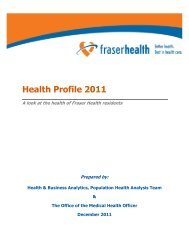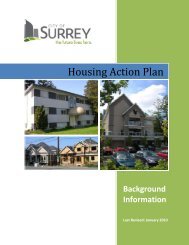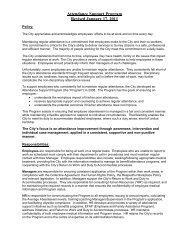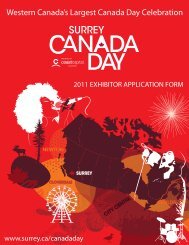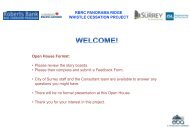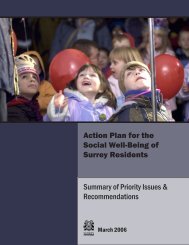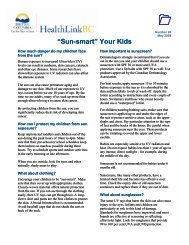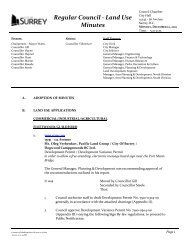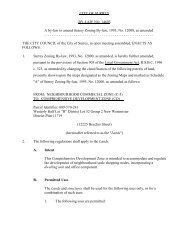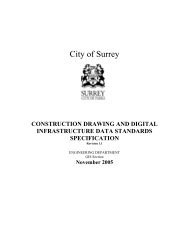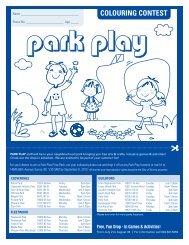Blackie Spit Park: Wildlife Habitat Enhancement Plan - City of Surrey
Blackie Spit Park: Wildlife Habitat Enhancement Plan - City of Surrey
Blackie Spit Park: Wildlife Habitat Enhancement Plan - City of Surrey
You also want an ePaper? Increase the reach of your titles
YUMPU automatically turns print PDFs into web optimized ePapers that Google loves.
Two documents used as reference material were discussed in Sections 1.1 and 1.2. The <strong>Blackie</strong> <strong>Spit</strong><br />
Master <strong>Plan</strong> (Berris et al 1999) contained goals and objectives for the park which became guidelines<br />
within which the MU plans were developed. It also contained direction regarding the specific<br />
management <strong>of</strong> certain features or areas. The second document referred to was the <strong>Blackie</strong> <strong>Spit</strong><br />
Regional <strong>Park</strong> <strong>Wildlife</strong> <strong>Habitat</strong> Management <strong>Plan</strong> (Summers 1997). It provided useful information<br />
and enhancement activities for several areas that were adopted or adapted for MUs to which that<br />
information could be applied.<br />
Field visits were done on July 30, August 10 and August 14, 2001. During those visits all parts <strong>of</strong><br />
the park were visited to record existing vegetation, the presence <strong>of</strong> invasive species, soil<br />
characteristics, moisture regime, topography, and the presence <strong>of</strong> trails and other use features. MU<br />
boundaries were modified as necessary from the preliminary map, and photographs were taken <strong>of</strong><br />
each MU.<br />
3.3 Management Units<br />
<strong>Blackie</strong> <strong>Spit</strong> has been subdivided into 19 Management Units based on physiographic, vegetation, and<br />
park use features (Figure 2). Most MU boundaries are reasonably intuitive, but occasionally, where<br />
changes in use are proposed, some portions <strong>of</strong> MU boundaries are drawn to expand or shrink the size<br />
<strong>of</strong> current features.<br />
3.3.1 Management Unit Goals and Objectives<br />
Management Unit Goals and objectives<br />
MANAGEMENT<br />
UNIT<br />
WILDLIFE/HABITAT<br />
GOALS<br />
1. Intertidal Aquatic migratory birds<br />
and shorebirds<br />
2. Rail Side Mixed coniferousdeciduous<br />
forest to<br />
provide habitat for a wide<br />
diversity <strong>of</strong> species<br />
groups (e.g. salamanders,<br />
woodpeckers, owls, bats<br />
(eventually), furbearers)<br />
HABITAT MANAGEMENT OBJECTIVES<br />
• On Cannery <strong>Spit</strong> and the central dyke, prevent<br />
vegetation from growing taller than 3 m to avoid<br />
discouraging bird access to the tidal areas;<br />
• Eliminate all trails within the management unit and<br />
allow intertidal area to remain undisturbed;<br />
• Support the nest box program for the red-listed purple<br />
martin (Progne subis) on the pilings just outside the<br />
park;<br />
• Maintain pilings within the MU as perching structures<br />
for marine associated birds and for possible purple<br />
martin nest box attachment.<br />
• <strong>Plan</strong>t trees and shrubs that will develop into a<br />
coniferous dominated mixed coniferous-deciduous<br />
forest;<br />
• Remove invasive species (e.g. blackberry, broom);<br />
• Continue to provide access only via the road along the<br />
southeast side and via the trail connecting to trails east<br />
<strong>of</strong> the park.<br />
<strong>Blackie</strong> <strong>Spit</strong> <strong>Park</strong>: <strong>Wildlife</strong> <strong>Habitat</strong> <strong>Enhancement</strong> <strong>Plan</strong> – PART 1: Background and Summary 9



